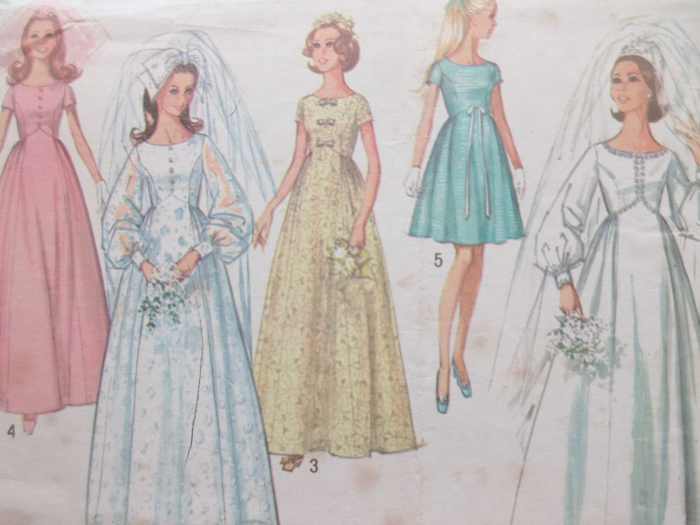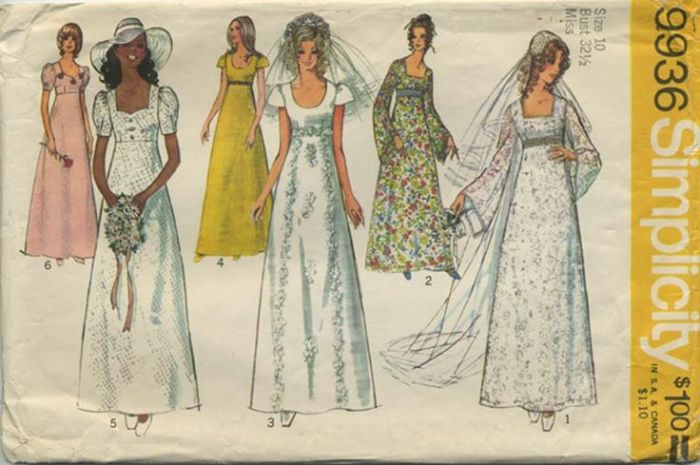Retro Wedding Dress Patterns A Timeless Guide
Retro Wedding Dress Patterns: A Timeless Trend

Source: etsystatic.com
Retro wedding dresses offer a captivating blend of vintage charm and modern elegance. From the flapper glamour of the 1920s to the romantic bohemian styles of the 1970s, these dresses offer a unique opportunity to express personal style with a touch of history. This exploration delves into the evolution of retro wedding dress patterns, providing guidance on sourcing, adapting, and constructing these iconic garments.
Retro wedding dress patterns offer a wealth of charming styles, often featuring elegant simplicity. Adding a modern touch is easy with adaptable elements like detachable sleeves; consider the versatility offered by removable cap sleeves for wedding dress , which can instantly change the look of a vintage gown. This allows for a truly personalized retro aesthetic, playing with different sleeve options to achieve the perfect balance of classic and contemporary.
Popularity and Trends in Retro Wedding Dress Patterns
The popularity of retro wedding dress patterns fluctuates with fashion trends, but certain eras consistently maintain their appeal. Understanding the defining elements of each decade is crucial for selecting and creating a truly authentic look.
The evolution of popular retro wedding dress styles across the decades showcases a fascinating interplay of societal influences and design innovation. The 1920s flapper dresses, with their dropped waistlines and shimmering fabrics, reflected the era’s rebellious spirit. The 1950s saw a resurgence of femininity with full skirts, cinched waists, and delicate lace, mirroring the post-war optimism. The 1960s embraced a simpler, more streamlined silhouette, often featuring A-line dresses and clean lines.
The 1970s introduced bohemian influences, with flowing fabrics, lace, and embroidery. Each decade’s style reflects the social and cultural climate of its time.
Key design elements distinguish these retro eras. Flapper dresses are characterized by their dropped waistlines, loose, flowing silhouettes, and often feature embellishments like beads and sequins. The 1950s are defined by full, cinched waists, often achieved with petticoats, and A-line or full circle skirts. 1970s boho dresses feature flowing fabrics like chiffon and lace, often with long sleeves or bell sleeves and intricate embroidery.
Silhouettes and fabrics varied significantly. The 1920s favored lightweight, shimmering fabrics like silk chiffon and charmeuse, while the 1950s utilized heavier fabrics such as satin, taffeta, and lace. The 1970s embraced flowing fabrics like chiffon, lace, and even crochet.
| Decade | Style | Silhouette | Notable Features |
|---|---|---|---|
| 1920s | Flapper | Dropped waist, loose-fitting | Beaded embellishments, fringe, cloche hats |
| 1930s | Bias-cut | Form-fitting, flowing | Long, elegant lines, often featuring long sleeves |
| 1940s | Tea-length | Fitted bodice, full skirt | Simple, elegant design, often with a sweetheart neckline |
| 1950s | A-line, full skirt | Fitted bodice, full circle or A-line skirt | Petticoats, cinched waist, often with lace or satin |
| 1960s | A-line, shift | Simple, straight or A-line | Minimalist design, often with a simple neckline |
| 1970s | Bohemian | Flowing, often with long sleeves | Lace, embroidery, flowing fabrics like chiffon |
Sourcing and Accessing Retro Wedding Dress Patterns

Source: pinimg.com
Finding the perfect retro wedding dress pattern requires exploring various avenues. The choice between vintage and reproduction patterns depends on individual preferences and sewing skills.
- Online marketplaces (Etsy, eBay): Offer a wide selection of vintage and reproduction patterns.
- Antique shops and vintage stores: Provide opportunities to discover unique and rare patterns.
- Pattern companies (Simplicity, Butterick, McCall’s): Offer reproduction patterns inspired by vintage designs.
- Online pattern archives and libraries: Provide access to digitized vintage patterns.
Vintage patterns offer the charm of originality but may require adjustments for modern sizing and construction techniques. Reproduction patterns provide updated sizing and instructions, ensuring a smoother sewing experience. Selecting a pattern depends on the sewer’s skill level and desired outcome. Beginners should start with simpler patterns, while experienced sewers can tackle more complex designs.
Adapting and Customizing Retro Wedding Dress Patterns
Altering a retro wedding dress pattern to fit individual measurements and body types is a crucial step in achieving a perfect fit. Various techniques can be employed to adjust the neckline, sleeves, and skirt length.
| Variation | Sleeve Style | Neckline | Other Features |
|---|---|---|---|
| 1 | Cap sleeves | Sweetheart | Full circle skirt, fitted bodice |
| 2 | Three-quarter sleeves | Boat neck | A-line skirt, nipped waist |
| 3 | Sleeveless | Scoop neck | A-line skirt, defined waistline |
Modern elements can be subtly incorporated into a vintage design. For instance, a modern fabric choice or a contemporary alteration to the neckline can update a classic style without compromising its retro charm. These techniques allow for personalized expression while honoring the original design’s integrity.
Fabric Selection and Construction Techniques
Appropriate fabric selection is essential for achieving the desired look and feel of a retro wedding dress. Understanding the construction techniques specific to various design elements ensures a professional finish.
- Silk: Ideal for creating a luxurious, flowing silhouette (1920s, 1930s).
- Lace: Adds a touch of romance and elegance (1950s, 1970s).
- Satin: Offers a sleek, polished look (1950s).
- Chiffon: Creates a light, airy feel (1970s).
Techniques like pleating, gathering, and darts are fundamental to achieving the characteristic shapes of retro dresses. Mastering these techniques is crucial for recreating the vintage aesthetic accurately.
Creating a 1920s Dropped Waistline: Begin by adjusting the pattern to lower the waistline. This involves extending the bodice and shortening the skirt. The dropped waistline should sit just below the natural waist. Carefully adjust the seams to ensure a smooth, flowing silhouette. Consider adding bias binding to finish the edges for a clean, professional look.
Creating a 1950s Petticoat: Cut the petticoat fabric according to the pattern. Gather the fabric at the waistline, ensuring even gathers. Attach elastic to the waistline, creating a comfortable fit. Add a layer of netting or tulle for extra fullness. Finish the hem with a rolled hem or bias binding.
- Sewing machine
- Scissors
- Measuring tape
- Pins
- Needles
- Thread
- Fabric
- Pattern
- Interfacing (as needed)
- Zipper (as needed)
Illustrating Retro Wedding Dress Designs

Source: tomandlorenzo.com
Visualizing the key characteristics of different retro wedding dress styles enhances the understanding of their unique aesthetics.
A 1930s bias-cut gown is characterized by its flowing, form-fitting silhouette, achieved through the use of bias-cut fabric. The fabric drapes beautifully, accentuating the body’s curves. Embellishments might include delicate beading or subtle lace detailing.
A 1940s tea-length wedding dress typically features a fitted bodice and a full, tea-length skirt. The overall aesthetic is one of simple elegance and understated glamour. The neckline is often a classic sweetheart or round neckline.
A 1960s A-line wedding dress emphasizes simplicity and elegance. The A-line silhouette is clean and uncluttered, often made from a lightweight fabric such as silk or cotton. The neckline is usually simple and understated, such as a bateau or scoop neck.
A 1970s bohemian wedding dress is characterized by its flowing fabrics, often featuring lace, embroidery, and flowing sleeves. The overall aesthetic is one of romanticism and free-spiritedness. The use of natural fabrics and earthy tones is common.
FAQs: Retro Wedding Dress Patterns
What are the most common mistakes when working with vintage patterns?
Common mistakes include not properly checking the pattern measurements against your own body measurements, misinterpreting the instructions, and using unsuitable fabrics.
How can I adjust a pattern for a plus-size figure?
Consult pattern adjustment guides and consider using a larger size as a base, then making necessary adjustments to ensure a comfortable and flattering fit. Professional alterations may also be necessary.
Where can I find reliable tutorials on retro sewing techniques?
Numerous online resources, including YouTube channels and sewing blogs, offer detailed tutorials on specific retro sewing techniques. Look for videos and articles focused on the era and techniques relevant to your chosen pattern.
What’s the difference between a vintage and a reproduction pattern?
Vintage patterns are original patterns from the era, often showing wear and tear. Reproduction patterns are modern copies of vintage designs, usually with clearer instructions and improved sizing.



















